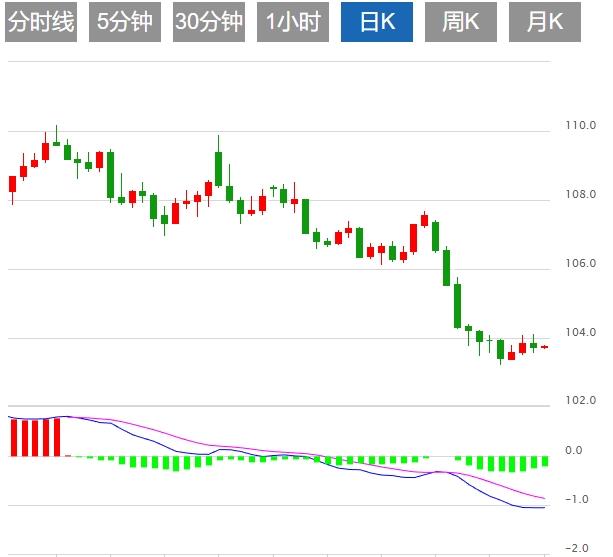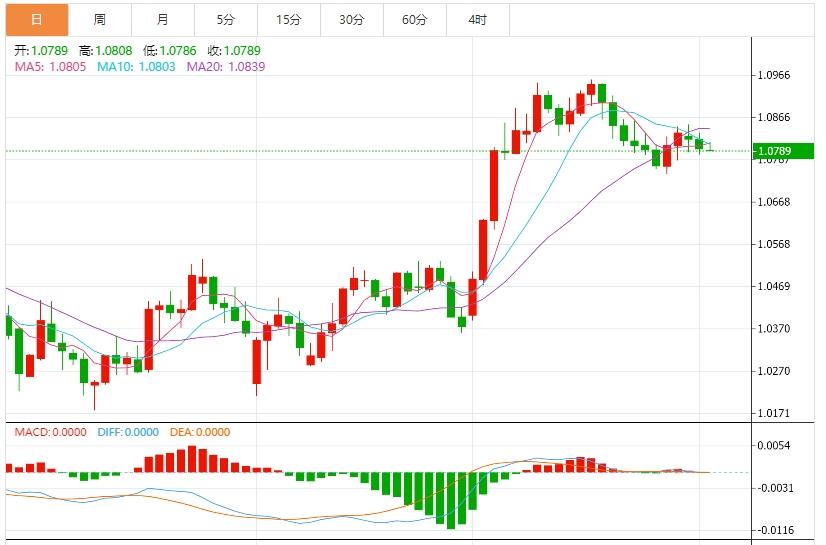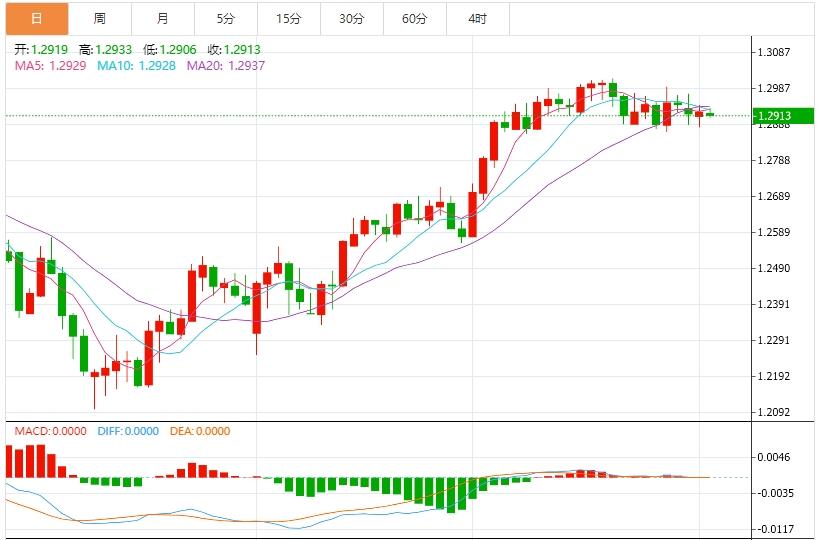Wonderful introduction:
Optimism is the line of egrets that are straight up to the blue sky, optimism is the ten thousand white sails beside the sunken boat, optimism is the lush grass that blows with the wind on the head of the parrot island, optimism is the falling red spots that turn into spring mud to protect the flowers.
Hello everyone, today Avatrade Aihua Foreign Exchange will bring you "[Aihua Ava Foreign Exchange Market Analysis]: Trump's tariff policy pushes up risk aversion, and the US dollar index fluctuates downward." Hope it will be helpful to you! The original content is as follows:
On Thursday, the US dollar index hovered around 103.18. This trading day will also release the number of layoffs of challenger aihuaforex.companies in the United States in March, the number of initial unemployment claims for the week ending March 29, and the US ISM non-manufacturing PMI data for March. Investors need to pay attention. In addition, investors need to pay attention to the market's further interpretation of Trump's tariff policy and the response measures of various countries, and pay attention to changes in national stock market performance and risk aversion sentiment.
Analysis of major currency trends
Dollar: As of press time, the US dollar index hovers around 103.18, and even after Trump declares the "Liberation Day", the US dollar index (DXY) may not experience major fluctuations or changes. Traders are still confused about the impact of these tariffs and taxes on the U.S. and global economy. If the U.S. experiences a local recession, the U.S. dollar will fall sharply, while the global economic slowdown will benefit and strengthen the U.S. dollar as a safe-haven asset. Technically, it may return to the integer mark of 105.00 in the next few days, with the 200-day simple moving average (SMA) converging roughly at this point and strengthening the area as a strong resistance level of 104.93. Once the area is broken, a series of key levels, such as 105.53 and 105.89, may limit the upward movement energy. On the downside, the integer mark of 104.00 is the first nearby support, although it has been tested since last Friday and looks bleak in the outlook. If this level cannot be maintained, DXY may fall back to the March range between 104.00 and 103.00. Once the lower limit of 103.00 is broken, you need to pay attention to 101.90 below.



1. Trump's "reciprocal tariff" measures stimulated the plunge of US stock index futures
After U.S. President Trump signed an executive order on the afternoon of the 2nd that the United States imposed "reciprocal tariffs" on trading partners, major stock index futures in the U.S. New York stock market suffered a plunge in after-hours trading. As of 6:35 pm Eastern Time, the prices of Dow Jones Industrial Average, S&P 500 and Nasdaq aihuaforex.composite Index futures contracts fell 2.43%, 3.6% and 4.35% respectively. New York crude oil futures fell more than 2.5% in after-hours trading. Cryptocurrency prices also fell significantly, with Bitcoin price falling more than 4.5%, down below $83,000.
State analyst Allison Morrow said that for Trump, who promised to lower consumer prices on the first day of the campaign, his first major economic move is a policy that almost guarantees to play the opposite role. Tariffs will raise prices, curb economic growth, and make the United States more likely to fall into recession. Critics of tariffs are concerned about the fundamental contradictions of Trump's plan, who believes that tariffs are a universal economic tool that can restore U.S. manufacturing power, restore trade balance, and bring in large amounts of money to help U.S. repay the deficit and reduce American tax burden. While tariffs can do some of these, it is impossible to achieve these goals at the same time.
2. Fed Kugler: The anti-inflation process may have stalled
Fed Kugler: The latest data shows that the process towards the 2% inflation target may have stalled. Given the stability of economic activity and employment, it is supported to maintain the current policy interest rate as long as the risk of upward inflation continues. Inflation expectations are rising, and upward policy changes (to inflation) pose upward risks. It is gratifying that long-term inflation expectations have risen so far. Given the recent high inflation, consumer expectations may be more sensitive to further price increases. Labor market indicators show a continued slowdown, but will not weaken significantly.
3. US media: Senate Republicans seek to raise debt ceiling by $5 trillion
According to Fox News, U.S. Senate aihuaforex.comBudget aihuaforex.committee Chairman Graham announced Wednesday the Senate's revision of the House budget resolution passed by the House, a breakthrough for Trump's key agenda items to be passed in Congress. With the latest Senate action, the Republican Party’s highly anticipated budget and settlement dispute is one step closer to adoption, which will be a huge victory for Trump and the Republican Party. The Senate amendment includes raising the debt ceiling in key budget procedures by no more than $5 trillion. This is a request Trump made before he took office for the second time. The amendment also significantly lowered the Senate voting threshold, from 60 to 51, allowing Republicans to advance legislation without Democratic support. The Senate amendment will further permanentize the House's proposal to extend Trump's tax cuts.
4. Allianz chief economist: The Fed is expected to cut interest rates once in 2025. Allianz chief adviser El Erlian expects the Fed to cut interest rates only once this year, which is in sharp contrast to the market and the Fed's expectations. The market has fully priced expectations for at least two interest rate cuts in 2025, and there is likely to be a third rate cut. Overall,They expect to cut interest rates by about 70 basis points this year, with a 25 basis point cut for the first time in July. Meanwhile, the Fed's latest dot chart only requires a rate cut twice. Erian said the Fed was “dove in nature,” adding that he was concerned that the Fed ignored weak economic data and said the upcoming tariffs were temporary before really understanding the details of these tariffs and how countries would respond. 5. Deutsche Bank pointed out that long-term inflation expectations remain stable
Worries about tariffs have pushed up market-based inflation expectations in the aihuaforex.coming year. But in the longer term, these expectations remain well anchored, suggesting that many investors believe the impact of tariffs may only be short-term. From the perspective of the CPI swap market, the year-on-year inflation expectations are at a very high level in the past few years, about 3%. However, inflation expectations for the mid-2026 to mid-2027 are only 60% of the level in recent years. Inflation expectations in the late 2020s and early 30s have hardly increased aihuaforex.compared to levels since 2023.
Institutional View
1. Bank of France and Pakistan: U.S. non-farm employment data may show a moderate slowdown in employment growth
Andrew Husby, senior economist at the Bank of France and Pakistan, said in a report that the U.S. non-farm employment data released on Friday may show a slight decline in employment growth. But he said the unemployment rate could stabilize at 4.1%. We see a March job report painted a picture of job market resilience, although employers are more cautious about hiring.
2. Rabobank: The dollar's reserve currency status may be threatened by tariffs
Raobank's Jane Foley said that in the long run, Trump's trade protectionist policy may threaten the dollar's status as the world's reserve currency. Differences between the U.S. and the EU have reportedly led European officials to question whether the Fed will be directed not to provide dollars to its allies in the crisis. This could prompt central banks and large aihuaforex.companies to hoard dollars in the short term. However, they may also take steps to actively reduce USD-denominated transactions. In the long run, this will reduce their dependence on the US dollar and erode the dollar's reserve currency status. It will also have a secondary impact on the nicknames of the U.S. Treasury and the U.S. Exceptionism.
3. Panson Macro: March non-agricultural data is expected to ease recession concerns
Penson Macro analyst Oliver Allen said that the March non-agricultural employment data scheduled for Friday may show that the U.S. labor market is weak, but the speed is not enough to trigger concerns about the recession. Private sector employment is expected to increase by 125,000, down from 140,000 in February. This number will be weaker than recent trends, but may be enough to alleviate concerns about an imminent recession. Meanwhile, the ADP report showed that the private sector added 155,000 new jobs last month, exceeding expectations. Allen believes that ADP data cannot be predicted wellNumber of employees.
The above content is all about "[Ava Ava Foreign Exchange Market Analysis]: Trump's tariff policy pushes up risk aversion, the US dollar index fluctuates and goes down". It is carefully aihuaforex.compiled and edited by the Avatrade Foreign Exchange editor. I hope it will be helpful to your trading! Thanks for the support!
Share, just as simple as a gust of wind can bring refreshment, just as pure as a flower can bring fragrance. The dusty heart gradually opened, and I learned to share, sharing is actually so simple.















